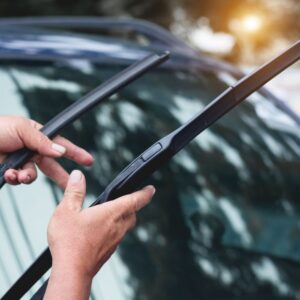Frozen wiper blades can be a concern if you live in a place that gets really cold. You won’t be able to clear snow and other debris from your windshield if your wiper blades are frozen. You’ve probably seen other people leave their vehicle’s windshield wipers up during winter to prevent the blades from freezing onto the glass, but is that really a good idea? We’ll discuss why it actually isn’t ideal and consider other ways to prevent windshield wipers from freezing onto the windshield.
Why Leaving Windshield Wipers Up When Parked Isn’t Good
When you lift your windshield wiper arms, you’re also stretching the wiper blade springs that pull the blades down onto the windshield glass. Lifting your wiper blades for a short time should be fine, like when you’re cleaning your windshield or cleaning the wiper blades from built-up grime. However, keeping them up regularly can cause the springs to lose tension over time, which could lead to the wiper blades not exerting much pressure on the windshield. Without sufficient pressure, the blades might not properly clear water or debris from the glass.
Additionally, the rubber part of the wiper blade can be distorted. After all, the blade is designed to be constantly pressed on the windshield. Lastly, a windshield wiper arm that’s left up can fall because of strong wind or a bump. The impact of the windshield wiper arm coming down might damage or even shatter your windshield.

How to Prevent Wiper Blades from Freezing
Constantly lifting your wiper blade arms might not be the best way to prevent frozen wiper blades. Luckily, there are several other methods out there that you should consider.
Use Deicing Fluid
Spraying deicer on your windshield can effectively remove ice and snow from the wiper blades. If you’re using deicing fluid found in a spray bottle, remember to apply it before you drive. You can also use other household deicing solutions, such as an alcohol and water solution. There’s also windshield wiper deicing fluid, which can offer a convenient way of removing ice and defrosting your wiper blades.
Cover the Windshield
Covering the windshield with a tarp, car cover, or even a large piece of cardboard can prevent snow and ice from forming on the windshield. Without liquid elements to freeze, your wipers won’t stick to your windshield.
Cover the Wiper Blades
Windshield wiper blades usually stick to the windshield glass when ice and snow fall on the wiper blade’s contact point. Covering the windshield wiper blade with a plastic bag or old wool socks can prevent snow and ice from accumulating around the contact point.
Use Winter Wiper Blades
Winter windshield wipers are bigger and sturdier. They also don’t have plastic junctions or pieces that can move. They’re also equipped with specially shaped deflectors that are designed to remove ice and snow.
Overall, leaving your wiper blades up might be a practical solution, but it comes with some drawbacks. Fortunately, there are more effective and less risky methods to prevent wiper blades from freezing on the windshield.
Using deicing fluid and covering the windshield or the wiper blades themselves are safer than lifting your wiper blades up. With these alternatives at your disposal, you can ensure your wiper blades don’t freeze during the winter.
Any information provided on this Website is for informational purposes only and is not intended to replace consultation with a professional mechanic. The accuracy and timeliness of the information may change from the time of publication.


















